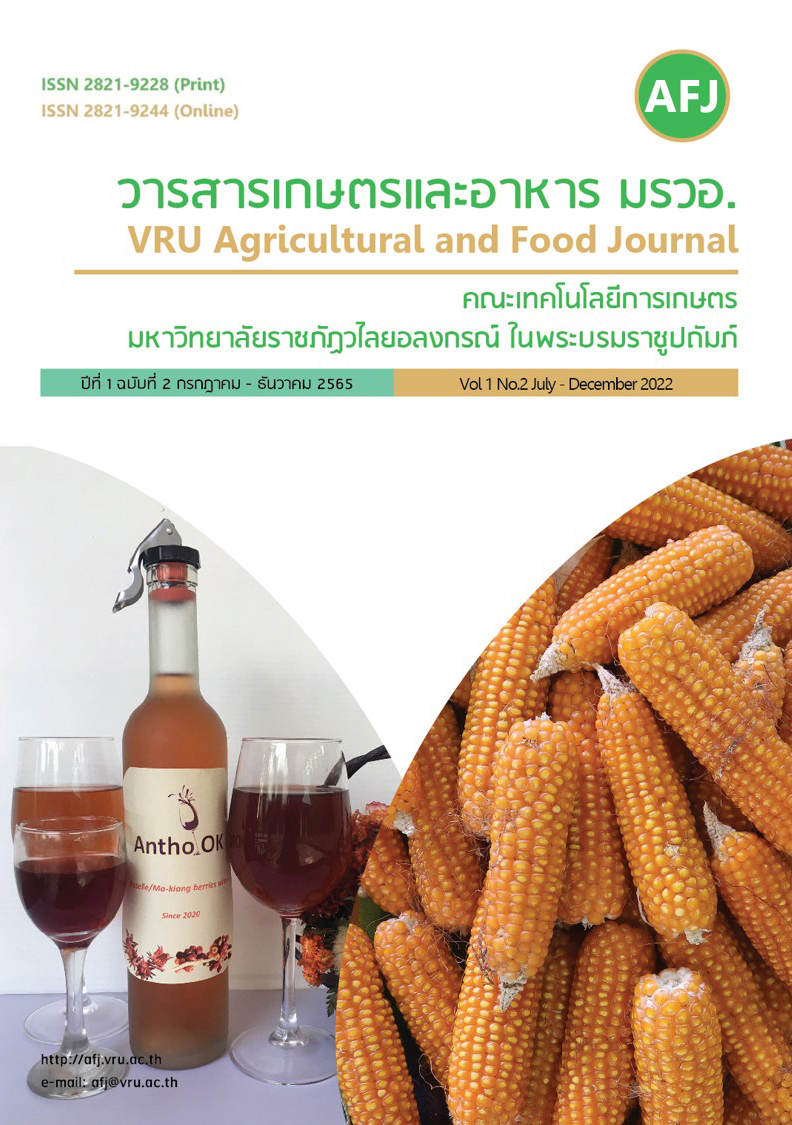Anthocyanin and Antioxidant Activity of Pink Wine Produced from Local Flowers and Ma-kiang Berries (Cleistocalyx nervosum var. paniala)
Main Article Content
Abstract
Anthocyanin is an important phytochemical found in flowers and fruits that gives the colour of pink wine. The objectives of this study were to compare anthocyanin and antioxidant activity of pink wine using (1) local flowers (hibiscus, red rose, pink lotus, and roselle) and (2) the flower wine with the highest alcohol content. Roselle was mixed with Ma-kiang berries to compare wine fermentation using different yeast starters (Montrachet, Cote des Blances, and Premier Cuvee). The wine process was fermented at 30oC for 15 days and then the wine was analysed anthocyanin, total phenolic compound, flavonoid, antioxidant activities (DPPH, ABTS, and FRAP), total soluble solids, pH, colour (L*, a* and b*) and alcohol content. It was found that pink wine fermented using the local flowers had alcohol content in the range of 6-12%, total soluble solid (TSS) 7.7-14.2 oBrix, and pH 2.70-3.18. The anthocyanin content in the pink wine, in descending order, was hibiscus, roselle, pink lotus, and red rose. Pink winemaking using different yeast strains had alcohol content in 5-9%, TSS 8.4-12.0 oBrix, and pH 2.90-3.03. Roselle/Ma-kiang berries wine fermented with Premier Cuvee had a higher content of anthocyanin, total phenolic compound, flavonoid, and all antioxidant activities than the two strains, Montrachet and Cote des Blances.
Article Details

This work is licensed under a Creative Commons Attribution-NonCommercial-NoDerivatives 4.0 International License.
This article is published under a Creative Commons Attribution-NonCommercial-NoDerivatives 4.0 International License (CC BY-NC-ND 4.0), which allows others to share the article with proper attribution to the authors and prohibits commercial use or modification. For any other reuse or republication, permission from the journal and the authors is required.References
Chaiyasut, C., Siramurathi, B. S., Pengkumsri, N., Sirilun, S., Peerajan, S., Chaiyasut, K. and Kesika, P. 2016. Anthocyanin profile and its antioxidant activity of widely used fruits, vegetables, and flowers in Thailand. Asian J. Pharm. Clin. Res., 9(6): 218-224.
Darwish, R. M. and Aburjai, T. A. 2011. Antimicrobial activity of some medicinal plants against different Candida species. Jordan J. Pharm Sci., 4(1): 70-80.
Du, B., He, B., Shi, P., Li, F., Li, J. and Zhu, F. 2012. Phenolic content and antioxidant activity of wine grapes and table grapes. J. Med. Plant Res., 6(17): 3381-3387.
Echevevrrigaray, S., Scariot, F., J., Menegotto, M. and Delamare, A. P. L. 2020. Anthocyanin adsorption by Saccharomyces cerevisiae during wine fermentation is associated to the loss of yeast cell wall/membrane integrity. Int. J. Food Microbiol., 2:314:108383.
Han, F. Ju, Y., Rusm, X., Zhao, X., Yue, X., Zhuang, X., Qin, M. and Fang, Y. 2017. Color, anthocyanin, and antioxidant characteristics of young wines produced from spine grapes (Vitis davidii Forex) in China. Food Nutri. Res., 61:1, 1339552,
Hisatomi, T. and Toyomura, K. 2021. Isolation, Identification, and characterization of wild yeast budding yeast from rose flowers in Fukuyama city, Hiroshima, Japan, and their application in bread and wine production. Mycoscience., 62Z6X: 382-389.
Loypimai, P. 2012. Total antioxidant capacity assessment in vitro. J. Sci. Technol. MSU. 31(2): 164-170.
Poontawee, W., Natakankitkul, S. and Wongmekiat, O. 2016. Protective effect of Cleistocalyx nervosum var. paniala Fruit extract against oxidative renal damage caused by cadmium. Molecules, 21, 133.
Patthamakanokporn, O. Puwastein, P., Nitithamyong, A. and Sirichakwal, P. P. 2008. Changes of antioxidant activity and total phenolic compounds during storage of selected fruits. J. Food Compos. Anal., 21: 241-248.
Prasanth, M. I. Brimsom, J. M., Chuchawankul, S., Sukprasansap, M. and Tencomnao, T. 2019. Antiaging, stress resistance, and neuroprotective efficacies of Cleistocalyx nervosum var. paniala fruit extracts using Caenorhabditis elegans model. Oxid. Med. Cell longev., ID7024785.
Prasanth, M. I, Sivamaruthi, B. S., Sukprasansap, M., Chuchawankul, S., Tencomnao, T. and Chiyasut, C. 2020. Functional properties and bioactivities of Cleistocalyx nervosum var. paniala berry plant: a review. Food Sci. Technol., 40 (Suppl 2)
Sarima, R. I. A. and Meryandini, A. 2019. Modulation of aging in yeast Saccharomyces cerevisiae by roselle petal extract (Hibiscus sabdariffa L.). Am. J. Biochem. Biotech., 15(1):23.32
Sirikhansaeng, P., Saenkhol, N. and Chumsena, L. 2020. The study of chemical properties and sensory test of roselle wine and roselle mix mulberry wine. RMUTTO R. J., 13(1): 111-119.
Srivanthana, B., Treesangsri, W., Boriboontrakul, B., Niumsakul, S. and Chavalittumrong, P. 2007. In vitro effects of Thai medicinal plants on human lymphocyte activity. Songklanakarin J. Sci. Technol., 29(sppl.1): 17-28.
Thai Industrial Standard Institute. 2003. Thai Community Product Standard, Fruit wine (TCPS 2/2546). Bangkok, Ministry of Industry.
Thai Industrial Standard Institute. 2003. Thai Community Product Standard, Herbal wine (TCPS 31/2546). Bangkok, Ministry of Industry.
Wauters, T., Iserentant, D. and Verachtert, H. 2001. Sensitivity of Saccharomyces cerevisiae to tannic acid is due to iron deprivation. Can. J. Microbiol. 47(4): 290-293.

